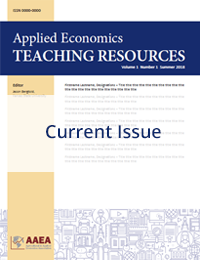Extension Education
Cross-Hedging in the Classroom: Engaging Students Scholarly Extension Output
Joel Cuffey(a), Wenying Li(a), Wendiam Sawadgo(a), and Adam Rabinowitz(a)
Auburn University(a)
JEL Codes: A20, A22
Keywords: Cross-hedging, Extension education, undergraduate teaching
First Published Online: June 26, 2022
Volume 4, Issue 2
View Full Article (PDF) | Request Teaching Notes/Supplemental Materials
Abstract
Topics covered by undergraduate agricultural economics courses often overlap with Extension educational needs. This paper describes an undergraduate class project that involved students in producing an Extension report. The project was designed as a collaboration between undergraduate instructors and Extension economists. The instructors targeted a set of concepts and skills for the students to practice, and the Extension economists advised the instructors on a particular issue using those skills relevant to local agriculture. This process resulted in analyzing the potential to cross-hedge peanuts with futures contracts from different commodities. Students were introduced to peanut marketing, cross-hedging, regression analysis, and how to write an Extension publication. In groups, students analyzed data and wrote a report. Group reports were evaluated by Extension economists, and one project was chosen to be published as a peer-reviewed Extension publication.
References
Barnard, F. L. 2003. “Using a Computer Simulation Game to Teach Agribusiness Management.” Journal of Extension. 41(5): 5TOT7. Available at: https://archives.joe.org/joe/2003october/tt7.php.
Beck, R.L., 1970. “Teaching Agricultural Price Analysis: a Dynamic Approach. NACTA Journal. 14(4): 78-80.
Bennett, C. F. 1976. Analyzing impacts of extension programs. ESC-575. Washington D.C.: US Department of Agriculture, Extension Service.
Curtis, K.R., and J. Mahon. 2010a. “Concreting the Student Learning Experience in Agricultural Economics through Field Research Projects.” North American Colleges and Teachers of Agriculture Journal 54(4):16–23.
Curtis, K.R., and J. Mahon. 2010b. “Using Extension Fieldwork to Incorporate Experiential Learning into University Coursework.” Journal of Extension 48(2): 2FEA4. Available at: https://joe.org/joe/2017august/a2.php.
Ebner, P., Constantinescu, A., Borlea, F., Indrea, A. and Russell, M. 2017. “Preparing Students for Extension Careers and Expanding US Extension Reach Through International Service Learning.” Journal of Extension. 55(4): v55-4a2. Available at: https://archives.joe.org/joe/2017august/a2.php.
Elliott, M.S., and L.M. Elliott. 2020. “Using Data Analytics and Decision-Making Tools for Agribusiness Education.” Applied Economics Teaching Resources 2(2):38–50.
Fannin, J.M. and LeBlanc, S.J. 2007. “Integrating University Service Learning Courses with Community Development Extension Programs.” Journal of Extension 45(2): 2IAW2. Available at: https://archives.joe.org/joe/2007april/iw2.php.
Haines, A. 2002. “Blended Teaching: Land Use Planning Education in Wisconsin and Lessons Learned.” Journal of Extension. 40(5): 5IAW2. Available at: https://archives.joe.org/joe/2002october/iw2.php.
Hoyt, G.M. 2021. “Learning by Giving Applied in an Upper-Level Course on the Economics of Altruism, Philanthropy, and Nonprofit Organizations.” The Journal of Economic Education 52(2):141–155.
Karisch, B. B., & Parish, J. A. 2013. “Assessment of Beef Cattle Extension Publication Use via Internet Download Monitoring.” Journal of Extension, 51(1): v51-1tt2. Available at: https://archives.joe.org/joe/2013february/tt2.php.
Lawrence, J., G. Hadley, and J. Henderson. 2019. “The Future for Extension Farm Management Economists: The Director’s Cut.” Choices 34(2). http://www.choicesmagazine.org/choices-magazine/theme-articles/the-future-of-farm-management-extension/the-future-for-extension-farm-management-economists-the-directors-cut.
Loveridge, S. 2003. “Strategies for Extension Specialists with Research or Classroom Instruction Assignments.” Journal of Extension. 41(5): STAW1. Available at: https://archives.joe.org/joe/2003october/iw1.php.
Marshall, E.C., and A. Underwood. 2019. “Writing in the Discipline and Reproducible Methods: A Process-Oriented Approach to Teaching Empirical Undergraduate Economics Research.” The Journal of Economic Education 5(1):17–32.
Patton, A. J., and J. E. Kaminski. 2010. "Tracking the impact of your web-based content." Journal of Extension 48(4): v48-4tt1. Available at: https://archives.joe.org/joe/2010august/tt1.php.
Peterson, P.E. 2018. Commodity Derivatives: A Guide for Future Practitioners. New York: Routledge.
Shear, H. 2020. “A Commentary on Extension Education Programming: An Overview of the CattleTrace Extension Program and Graduate Extension Education.” Applied Economics Teaching Resources 2(4):57–62.
Swinton, S.M. 2021. “Learning about Consumer Demand from Student Surveys.” Applied Economics Teaching Resources 3(3):147–155.
Taylor, M., and W. Zhang. 2019. “Training the Next Generation of Extension Economists.” Choices 34(2). http://www.choicesmagazine.org/choices-magazine/theme-articles/the-future-of-farm-management-extension/training-the-next-generation-of-extension-economists.
Articles in this issue
On the Strategic Creation of Extension and Outreach Content in a New Media Environment
Trey Malone, Jim Monahan, Katie Nicpon, K. Aleks Schaefer, and Madelyn Cary
Extension Programming During a Pandemic: The Cooperative Director Foundations Program
Michael A. Boland, Christopher J. Kopka, Keri L. Jacobs, Courtney Berner, Brian C. Briggeman, Matthe
Can We Foster the Future of Extension through (Friendly) Competition? The Past, Present, and Future of the Graduate Student Extension Competition
Aaron J. Staples, Carlos A. Fontanilla-Diaz, Kate Binzen Fuller, and Maria I. Marshall
Nurturing International Graduate Students for a More Diversified and Inclusive Extension Workforce
Yangxuan Liu and Wendong Zhang
Cross-Hedging in the Classroom: Engaging Students Scholarly Extension Output
Joel Cuffey, Wenyig Li, Wendiam Sawadgo, and Adam Rabinowitz
Engaged Learning: Linking Course Instruction and Extension Programming
Todd M. Schmit, Richard Stamm, and Roberta M. Severson


